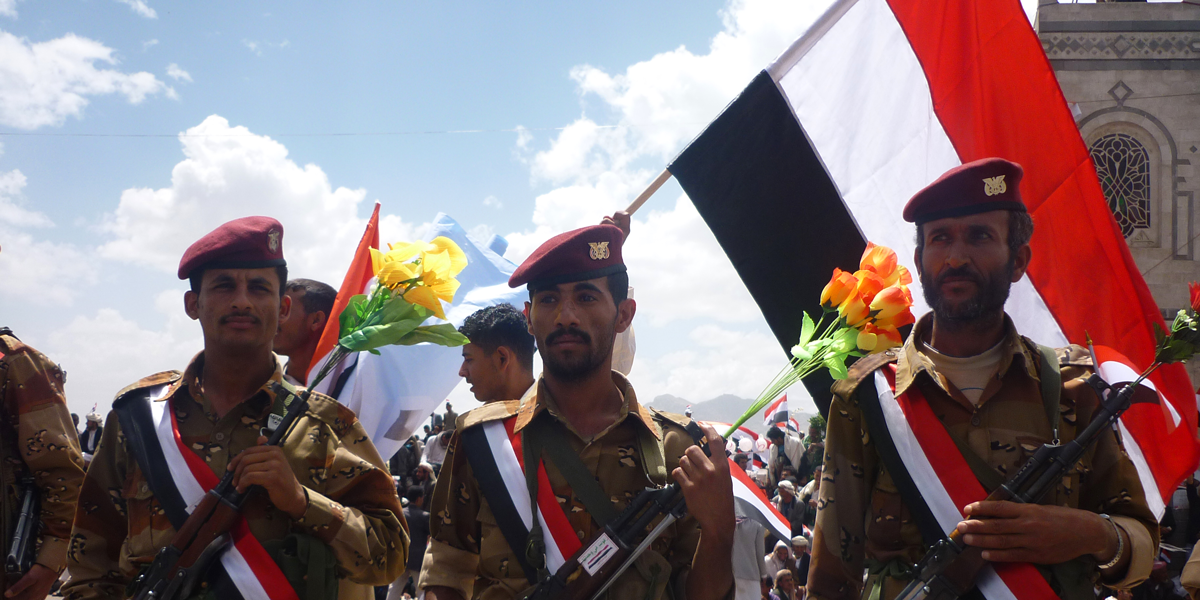
This article was originally published by The Foreign Policy Centre (FPC) on November 14 2018.
The diffusion of protests against authoritarian regimes across the Arab world in 2011 reinvigorated Yemen’s marginalized social movements and united different geographical and political factions in Yemen, such as the northern Houthi movement and the southern secessionist movement Hiraak.1 The Saudi Kingdom, along with other Gulf monarchies, swiftly designed a transitional plan for the country to ensure that President Ali Abdullah Saleh wass replaced with a friendly government led by President Abd Rabo Hadi. Disillusioned by the transition, the Houthis took military control of the capital Sana’a in September 2014, and Yemen descended into a civil war. On 26 March 2015, Saudi Arabia launched airstrikes on Yemen with the aim to restore the Saudi-backed Hadi government and destroy the Houthi movement. What was initially planned as a limited operation degenerated into a war of attrition without a conclusion insight. Scholars and policy analysts moved quickly to examine the Yemen war as a by-product of Saudi-Iranian rivalry and another manifestation of a region-wide war between Sunni and Shi’a Muslims. Yet, the crisis in Yemen is more complex; it is neither an international proxy war nor a sectarian confrontation.
First, the Iranian role in Yemen has been exaggerated and even deliberately distorted by the Saudi Kingdom to legitimize its military intervention. The Houthi movement is a tribal group that is rooted in the Yemeni political context, and the group’s decisions and political goals are rooted in its local Yemeni leadership.2 Some evidence suggests that Iran’s links to the Houthis might have increased at the end of 2014.3 Yet, this evidence remains suggestive at best. The UN Panel of experts on Yemen has stated in January 2017 that there was ‘no sufficient evidence to confirm any large-scale direct supply of arms from the government of the Islamic Republic of Iran’.4 Instead, the Houthis have received military support from their most important ally, the former President Saleh, whose army was equipped with US weapons. In other words, Iran’s marginal involvement has no effect on the underlying structure of the conflict.5
Second, depicting the political struggle in Yemen as a mere sectarian binary is simplistic. Although the Houthi movement belongs to the Zaydi sect, a branch of Shiism, it is wrong to assume that the Yemen crisis is driven by primordial identities. Zaydism is distinct from the ‘Twelver Shiism’ found in Iran both in doctrine and practice, and the theological difference between both Zaydi and Twelver Shiism leaves the Zaydis closer to Sunni Islam. The Zaydis present themselves as a separate sect distinct from both Shiism and Sunnism. It is also worth noting that Saleh’s supporters from the Yemeni army fighting with the Houthis are Sunnis.6
Instead, the recent crisis in Yemen can be viewed as a civil war between groups in a political struggle, and with international interference. Although sectarianism is alien to Yemeni religious culture, several observers have noticed a growing sectarian polarization in Yemen that relies on borrowing sectarian slurs from the conflicts in Iraq, Syria and Lebanon. The Houthi movement is often called as ‘Twelver Shiites’, ‘the new Hizballah of the Arabian Peninsula’ or an ‘Iranian puppet’. The Houthis have also used sectarian terms to refer to their opponents, such as takfiris and daeshites.7
Iran’s ambitions in Yemen are limited and do not wish to escalate the conflict with Saudi Arabia. Yet, local actors involved in the conflict have an interest in borrowing sectarian narratives to mobilize international support and resources by situating their struggle in the regional meta-narrative. President Hadi has adopted an anti-Shiite narrative in his confrontation with the Houthis to maintain the support from Gulf countries, who perceive the Iranian expansion in the region as the most dangerous threat. The Houthis would like more support from Iran by adopting slurs from the ‘’Twelver Shiite’’ vocabulary and using famous historical symbols, such as the name of Hussein. The Saudi Kingdom is also interested in providing legitimacy for its military operation, especially at home, and sectarianism provides a wide support for the operation. In short, sectarianism in Yemen remains alien to the local culture but has grown as a strategic war narrative used by local and international actors.
Although Yemen lacks the sharp sectarian divides found in Iraq, Bahrain, and Syria, the sectarianisation of the political transition in Yemen generates distinct junctures, which are likely to have long-lasting implications on Yemen and the region. First, this venom of sectarian hatred that speeded into the Yemen conflict has destroyed centuries of tolerance between the Islamic schools in Yemen, which might take decades to rebuild. Furthermore, the sectarian violence in Yemen made the conflict less localized and increasingly internationalised, which renders the conflict resolution more difficult.
Notes
1 For more details on the movement and its development, see International Crisis Group, Breaking Point? Yemen’s Southern Question, October 2011, https://www.crisisgroup.org/middle-east-north-africa/gulf-and-arabian-peninsula/yemen/breaking-point-yemen-s-southern-question
2 Joost R. Hiltermann and April Longley Alley, The Houthis Are Not Hezbollah, Foreign Policy, February 2017, https://foreignpolicy.com/2017/02/27/the-houthis-are-not-hezbollah/
3 W. Andrew Terrill, Iranian Involvement in Yemen, Orbis vol. 58, no. 3 (2014), p.438; Thomas Juneau, Iran’s Policy towards the Houthis in Yemen: A Limited Return on a Modest Investment, International Affairs vol. 92, no. 3 (2016), p. 657.
4 UN Security Council, Final Report of the Panel of Expert on Yemen, January 2017, http://www.securitycouncilreport.org/atf/cf/%7B65BFCF9B-6D27-4E9C-8CD3-CF6E4FF96FF9%7D/s_2017_81.pdf
5 Elizabeth Kendall, Iran’s Fingerprints in Yemen: Real or Imagined?, Atlantic Council, October 2017, http://pushback.atlanticcouncil.org/papers/irans-fingerprints-in-yemen-real-or-imagined/
6 Anna Gordon and Sarah Parkinson, ‘How the Houthis Became ‘Shi‘a,’ Middle East Report Online, January 2018, http://www.merip.org/mero/mero012718
7 Al-Muslimi, Farea, How Sunni-Shia Sectarianism Is Poisoning Yemen. Carnegie Middle East Center, December 2015, http://carnegie-mec.org/diwan/62375
About the Author
May Darwich is an Assistant Professor in International Relations of the Middle East in the School of Government and International Affairs (SGIA) at Durham University, in the United Kingdom.
For more information on issues and events that shape our world, please visit the CSS website.

